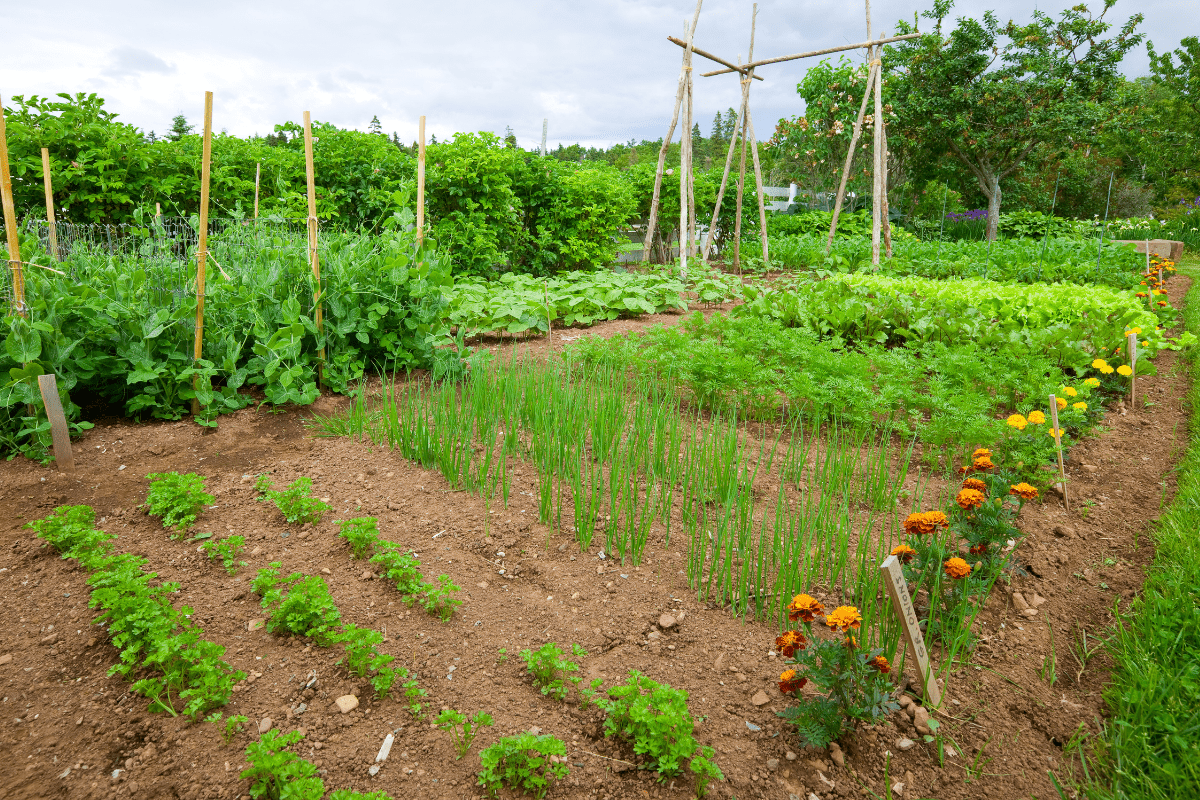Idaho's dramatic landscape creates one of America's most diverse growing environments, with nine distinct hardiness zones spanning from the warm Snake River Valley to frigid mountain peaks. This remarkable climate diversity means that somewhere in Idaho, something delicious is always in season…if you know where to look and when to harvest. Whether you're planning a garden in Boise's 190-day growing season or navigating McCall's challenging 69 frost-free days, this guide provides the practical information you need to make the most of Idaho's seasonal bounty.
Understanding Idaho's Growing Regions
Idaho's growing conditions vary more dramatically than almost any other state, and understanding your specific region shapes everything from what you can grow to when you'll harvest it.
The Treasure Valley around Boise enjoys zone 7a conditions with approximately 190 frost-free days, making it ideal for diverse crops including the state's famous stone fruits. If you're gardening here, consider yourself lucky. You can grow practically anything with a little water and attention.
Northern Idaho benefits from surprising maritime influence, creating moderate conditions perfect for berries and cool-season crops. Meanwhile, Eastern Idaho's high desert climate presents its own challenges with a 125-day growing season, and central mountain areas like McCall face extremely short 69-day windows that demand serious creativity.
These regional differences mean that while Boise gardeners harvest tomatoes in July, their McCall neighbors might still be protecting young plants from frost. The 2023 USDA zone update showed significant warming across Idaho, with many areas shifting up one full zone. That's great news for adventurous gardeners wanting to try new crops, though it also means paying closer attention to water conservation.
Spring Awakens with Fresh Greens and Wild Treasures
Spring arrives gradually across Idaho, and by "gradually," I mean it teases us mercilessly with warm days followed by surprise freezes.
The Asparagus Champion
Asparagus leads the charge each spring, with commercial fields producing up to 5 inches of growth daily during peak season around Mother's Day. Home gardeners should plant Jersey Giant or Jersey Knight varieties, which thrive in Idaho's alkaline soils and produce for decades with proper care. Once established, an asparagus bed becomes that reliable friend who shows up every spring without fail.
Cool-Season Vegetables Thrive
Cool-season greens flourish in Idaho's spring conditions, often performing so well that gardeners can succession-plant them every two weeks for continuous harvest. Your spring garden arsenal should include:
- Spinach and lettuce varieties
- Kale and Swiss chard
- Peas (snow and snap)
- Radishes and turnips
- Early cabbage and broccoli
Wild Spring Edibles
Spring also brings prime morel hunting in recently burned forest areas. These elusive mushrooms sell for astronomical prices at farmers markets, making a successful foraging trip feel like striking gold. Young dandelion greens and wild asparagus along irrigation ditches offer free salad ingredients for those who know where to look.
However, and this is crucial, Idaho hosts several deadly look-alike plants including death camas. If you're not 100% certain of identification, don't eat it. Period. Join local foraging groups or take classes before venturing out solo.
Spring's edible flowers include pansies and violets, which add color and mild flavors to salads. Native plants like arrowleaf balsamroot paint hillsides yellow, while blue camas blooms in meadows. Modern foragers should note that blue camas requires extensive cooking to be safely edible and grows dangerously close to its poisonous cousin.
Summer Brings Stone Fruit Glory
Idaho's summer showcases why the state ranks as America's fifth-largest sweet cherry producer, and honestly, once you've tasted a sun-warmed Idaho cherry straight from the tree, grocery store fruit loses all appeal.
Cherry Season Details
The harvest begins mid-June with early varieties like Chelan, progressing through the famous Bing and Rainier cherries in July. Commercial orchards concentrate in Canyon, Washington, Payette, and Gem counties, where the combination of hot days, cool nights, and volcanic soils creates ideal growing conditions.
Home gardeners throughout southwestern Idaho successfully grow cherries, though tart varieties like Montmorency prove more forgiving of spring frost damage. The trees require patience…you'll wait several years for your first real harvest…but the payoff is worth it.
Stone Fruit Parade Continues
The summer fruit succession continues with:
- Apricots in late July
- Peaches through August
- Nectarines overlapping with peaches
- Early plums beginning in August
These fruits require dedicated care but reward growers with flavors that explain why people line up at u-pick orchards throughout the Treasure Valley. Idaho specimens often grow larger and sweeter than their grocery store counterparts, making the effort worthwhile.
Summer Vegetable Abundance
Summer vegetables thrive statewide with proper variety selection. Tomatoes and peppers need protection and early starts in short-season areas but produce abundantly with season extension techniques. The traditional "Three Sisters" planting of corn, beans, and squash grows well throughout Idaho, creating both garden beauty and dinner ingredients.
By August, zucchini proves so prolific that gardeners resort to leaving anonymous bags on neighbors' doorsteps. It's practically an Idaho tradition at this point.
The Huckleberry Hunt
Wild huckleberries, Idaho's state fruit, ripen from mid-July through August in mountain areas between 4,000-6,000 feet elevation. These prized berries cannot be cultivated commercially, making wild harvest the only option.
Popular picking areas include the Coeur d'Alene National Forest, Priest Lake region, and mountains around McCall. Successful foragers start early in the morning, carry bear spray, and never reveal their best spots. Seriously, asking someone for their huckleberry location is like asking for their banking password.
Fall Delivers the Famous Idaho Potato
No discussion of Idaho produce would be complete without potatoes, and fall brings the main harvest that built the state's agricultural reputation.
Potato Harvest Timeline
From early September through October, farmers dig millions of pounds of russets, with the famous Burbank variety leading production. Home gardeners can grow potatoes successfully statewide, planting in April for September harvest. The key lies in hilling…gradually mounding soil around growing plants to increase yields and prevent green potatoes.
Root Vegetable Bonanza
Fall's root vegetables provide the foundation for winter eating. These storage champions include:
- Carrots (try purple varieties)
- Beets (golden are milder)
- Parsnips (sweeten after frost)
- Turnips and rutabagas
- Winter radishes (daikon stores beautifully)
Winter squash varieties like butternut and acorn cure in the field before providing months of eating. Brussels sprouts and other brassicas actually improve in flavor after frost, making them ideal for Idaho's climate.
Apple Season
Apple harvest extends from August's early Gala variety through October's late-season Fuji and Granny Smith. Idaho's apple orchards, concentrated in the Treasure Valley between the Snake and Payette rivers, use sophisticated controlled-atmosphere storage to provide fresh apples year-round.
Home orchardists should select varieties based on their specific zone and chill hours, with heritage varieties often proving more resilient than modern cultivars. A well-chosen apple tree can produce for generations, making it a true investment in your property.
Fall Foraging Opportunities
Fall foraging focuses on rose hips, elderberries, and chokecherries. Pine nuts from piñon pines provide a labor-intensive but rewarding harvest in central and southern Idaho's higher elevations. Mushroom hunters find chanterelles and porcini in forest areas, though proper identification remains critically important.
Winter Sustains Through Storage and Creativity
Idaho's winter produce availability depends largely on storage traditions developed over generations of practical necessity.
Root Cellar Basics
Root cellars maintain potatoes, apples, and root vegetables at optimal temperatures between 32-40°F with 80-95% humidity. Modern adaptations include insulated basement rooms, buried containers, and converted garages that don't freeze. Proper storage extends the harvest by months…Idaho potatoes famously store until the following summer when managed correctly.
Season Extension Techniques
Greenhouse and cold frame growing extends fresh production through winter months. Cold frames create microclimates 1.5 zones warmer than surrounding areas, allowing harvest of lettuce, spinach, kale, and herbs even in January.
Simple structures built from recycled windows and straw bales protect hardy vegetables while more elaborate greenhouses enable year-round production. In places like McCall with its 63-day growing season, these techniques transform from helpful to absolutely essential.
Winter Market Options
Winter farmers markets keep local food connections alive through cold months:
- Idaho Falls monthly indoor markets
- Various Treasure Valley venues
- Kootenai County's "Cabin Fever" markets
- Only Local Farmers Market (year-round)
Finding Idaho's Seasonal Bounty
Accessing local produce requires knowing where to look throughout the seasons.
Farmers Market Network
Idaho hosts over 50 farmers markets operating from spring through fall. The Boise Farmers Market, the state's largest, runs Saturdays from April through October, featuring everything from spring asparagus to fall storage crops. The Idaho Farmers Market Association provides a comprehensive directory for finding markets near you.
CSA Programs
Community Supported Agriculture programs connect consumers directly with farmers for weekly produce boxes. Options range from organic vegetables to refugee-operated cooperatives introducing international varieties to Idaho plates. Many CSAs offer work-share options where members help harvest in exchange for reduced prices.
U-Pick Adventures
U-pick operations dot the state, offering both better prices and family experiences. The Berry Ranch in Nampa provides berries from June through October, while Emmett's numerous orchards offer stone fruits and apples in season. Eastern Idaho's Grove City Gardens and Haroldsen Farm specialize in vegetables and berries adapted to shorter growing seasons.
Growing Success in Your Idaho Garden
Success in Idaho gardens comes from understanding and working with your specific conditions rather than fighting them.
Zone-Specific Strategies
Short-season gardeners must embrace these essential techniques:
- Start seeds indoors 6-8 weeks early
- Choose early-maturing varieties exclusively
- Maximize south-facing microclimates
- Use cold frames religiously
- Accept some crop limitations
Water conservation grows increasingly important as climate patterns shift. Drip irrigation, heavy mulching, and drought-resistant varieties help gardens thrive with less water. Native and adapted plants like currants, serviceberries, and sage naturally handle Idaho's dry summers once established.
Foraging Safety and Ethics
Idaho's wild edibles provide free food for knowledgeable foragers, but safety must come first. Never eat any plant without 100% positive identification. Death camas, poison hemlock, and water hemlock grow throughout Idaho and have killed careless foragers.
Start with easily identified species like dandelions and rose hips before advancing to mushrooms or root vegetables. Join the Idaho Native Plant Society or local mushroom clubs for expert-led foraging trips that build identification skills safely.
Sustainable foraging follows the "rule of thirds"…harvest no more than one-third of available plants, leaving the rest for wildlife and regeneration. National forests generally allow personal-use gathering up to one gallon daily without permits, though mushroom foraging may require free permits.
Preserving the Bounty
Idaho's preservation traditions provide both food security and superior flavors year-round.
Altitude-Adjusted Canning
Pressure canning remains essential for safe preservation of low-acid vegetables at Idaho's elevations. The University of Idaho Extension offers free pressure canner gauge testing and research-based recipes adjusted for altitude. Water bath canning works beautifully for Idaho's abundant fruit crops, creating jams and jellies that capture summer sunshine.
Modern Preservation Methods
Today's preservation options include:
- Freezing berries on sheets first
- Blanching vegetables before freezing
- Solar or electric dehydration
- Freeze-drying (increasingly popular)
- Traditional root cellaring
Even apartment dwellers can create small cold-storage areas in closets or unheated spaces for potatoes, apples, and winter squash.
Making the Most of Idaho's Seasons
Idaho's seasonal produce offers year-round abundance for those who understand the state's diverse growing conditions. Success comes from working with rather than against local climate, selecting appropriate varieties, and embracing both modern techniques and traditional knowledge.
Start small, learn continuously, and connect with Idaho's generous community of growers and food preservers. Join local gardening groups, attend Extension workshops, visit farmers markets regularly, and experiment with new crops and techniques. Each season brings new possibilities, from spring's tender asparagus to winter's stored abundance, creating a sustainable food system that nourishes both people and land throughout Idaho's magnificent landscape.



